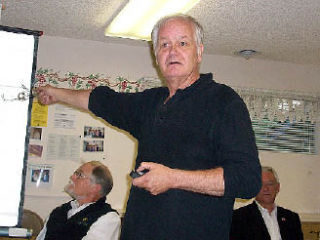PUD backers say they are close to reaching goal for Nov. 4 ballot
FREELAND — While praising the benefits of a public utility district, the group advocating local control over electric power on the island remained tightlipped during a public meeting about what a PUD would cost the taxpayers.
A crowd of more than 50 showed up at the panel discussion Wednesday night in Freeland to discuss the future of energy on Whidbey Island. “People For Yes on Whidbey PUD” want to form a public utility district on the island.
The group promotes local control over energy supply and maintenance. Currently the island is served by Puget Sound Energy, the state’s largest electric and natural gas utility with more than 1 million electric customers in 11 counties.
A panel of experts answered questions from residents, including islanders from Clinton to north of Oak Harbor.
However, supporters did not reveal an estimate on what the local PUD would cost.
Dave Johnson, general manager of Skagit County PUD, said his district has researched what it would cost to buy PSE’s lines, poles, buildings and other infrastructures, as well as set up a electric PUD and pay for legal fees associated with a takeover in Skagit County. The estimate came to $520 million.
“It seems like a lot of money, but what you’re really looking at is a 50- to 100-year decision,” he said.
Bob Geddes, general manager of the Pend Oreille County PUD, the oldest PUD in the state, agreed.
“Jobs, revenues and resources stay in the community,” he said.
To cover start-up costs and potential lawsuits, “People For Yes on Whidbey PUD” organizers said they would consider a property tax levy that could be as high as 45 cents per $1,000 of assessed property value.
PUD authorities from afar said it was simple to tap the public to pay for the project.
“Probably the easiest is using the taxing authority,” said Robbie Robertson, a commissioner for the Skagit County PUD. “It’s probably the easiest to get your funding base started.”
Johnson added that people should consider future rate increases due to PSE’s financial situation and compare it with the impact of a tax increase.
A tax increase may be the better deal, he said.
However, it could be a long wait until that point arrives. And the journey may be filled with lawsuits.
“PSE is going to fight tooth and nail and they are financially the big dog,” said Ed Jenkins, a spokesman for “People For Yes on Whidbey PUD.”
PSE has a long history of fighting PUDs in the media via ad campaigns, as well as in the courts.
Jenkins said staying with PSE is a bad idea because the company is accumulating debt quickly and service is only going to get worse, but more expensive.
“What’s our option?” Jenkins asked. “If we’re staying with PSE, we’ll have nothing but continuing problems.”
An audience member wanted to know how much time it would take between the initial vote and the first customers could be served by a local PUD if Island County voters approve the formation of a local utility on the November ballot.
The experts had no definite answer. They said it could be as fast as one or two years, but could stretch more than a decade.
The Skagit PUD expects to be in business within two to five years, including legal action and possible condemnation of PSE property.
The experts agreed that legal action is likely and that PSE won’t give up the rights to power lines, poles and infrastructure without a fight.
“You probably end up in court. Puget loves to go to court and that could take a while,” said Tom Andersen, a PUD advisor.
“They have an army of lawyers,” added Steve Johnson, executive director of the Washington Public Utility Districts Association.
But even if PSE won’t cooperate, there are other ways to gain local control.
“We can condemn the assets,” Robertson said. “That’s the nuclear option.”
But the evening was not all talk about the money. The panelists talked at length about possibilities in conservation and “green methods.”
One of the panelist found many fans among the audience.
Mike Nelson, director of the Northwest Solar Center, outlined how solar energy will outpace any other forms of energy in the not-too-distant future.
“Photovoltaics can be made of sand,” he said. “Any time you can make something out of sand, I say, do it.”
He said that production cost of solar power will drastically drop in the future and that most of the technology needed is being manufactured in Washington. He also said the government is supporting solar energy.
“Washington is the first state that puts out incentives based on the German model,” he said. “You get paid for making electricity.”
The organizers of the meeting had invited a number of local politicians to take part in the panel. None of the island mayors attended, however.
County Commissioner Phil Bakke sat on the panel and reported that the Council of Governments had discussed the PUD option earlier that day and decided to be helpful in the effort. The council will provide information so voters could make an informed decision, Bakke said.
In order to get the issue on the ballot this fall People For Yes on Whidbey PUD have to collect 2,392 signatures from registered voters living on the island — or 10 percent of all registered voters — by July 4.
Organizers said their signature campaign was going well and they were close to reaching their goal.
They would not say how many signatures they had collected.
“We’re really close to qualifying for the ballot,” said David Metheny, campaign director for “People For Yes on Whidbey PUD.”
“It looks like we’re probably going to make it.”
Michaela Marx Wheatley can be reached at 221-5300 or mmarxwheatley@southwhidbeyrecord.com.



